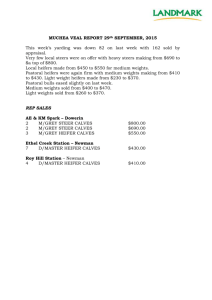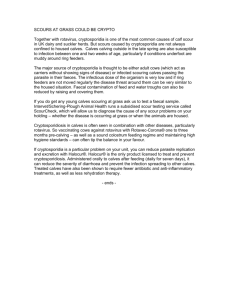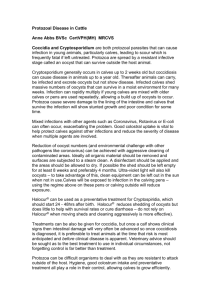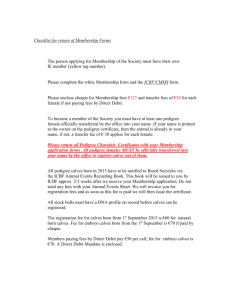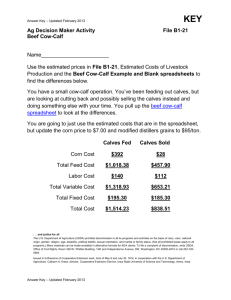1 Efficacy of blood plasma IGF I as a marker and implications of
advertisement
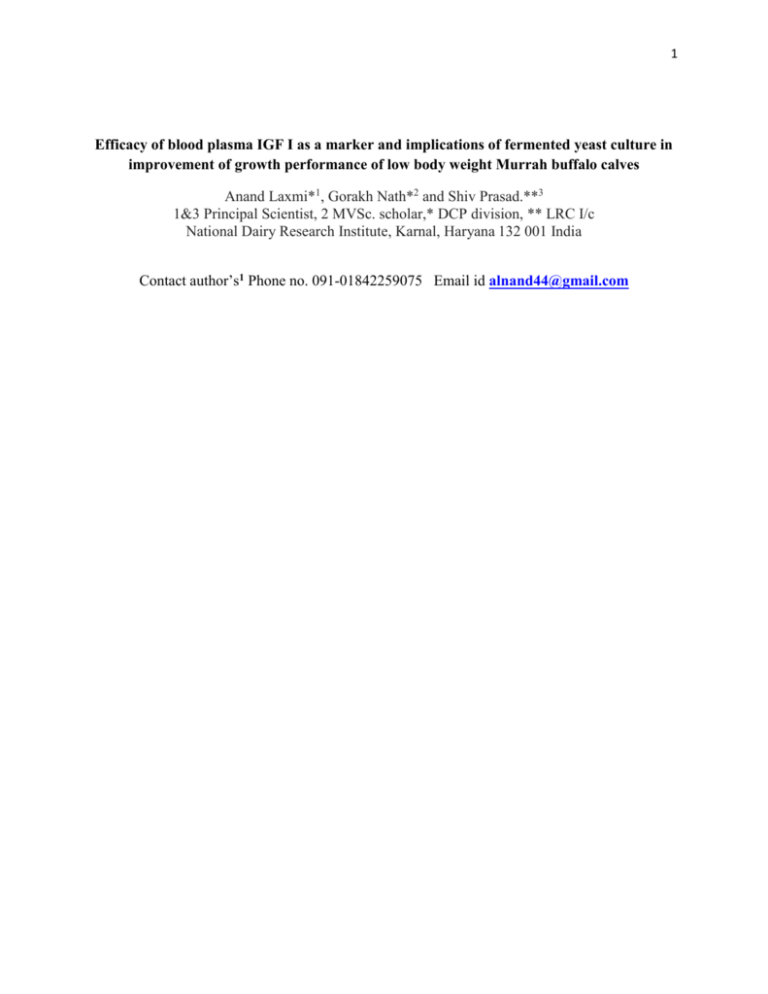
1 Efficacy of blood plasma IGF I as a marker and implications of fermented yeast culture in improvement of growth performance of low body weight Murrah buffalo calves Anand Laxmi*1, Gorakh Nath*2 and Shiv Prasad.**3 1&3 Principal Scientist, 2 MVSc. scholar,* DCP division, ** LRC I/c National Dairy Research Institute, Karnal, Haryana 132 001 India Contact author’s1 Phone no. 091-01842259075 Email id alnand44@gmail.com 2 ABSTRACT: To find relationship between plasma IGF I and Haptoglobin and body weight in low body weight male and female Murrah calves and to increase the body weight by supplementation of fermented yeast culture and study its effect on blood plasma parameters. According to the technical program low body weight (BW) Murrah calves (male and female) of 100±10kg BW at ten months of age were selected from the animal herd. The experiment was carried out between November 2012 and March 2013. They were divided into control and experimental groups respectively. In the experimental group supplementation of fermented yeast culture Saccharomyces cerevisiae (SC), was done by mixing it along with concentrate (300g/quintal). In each group for both male and female calves, there were six numbers of animals. To the control group, SC was not offered with diet. In blood plasma IGF I and Haptoglobin were estimated. It was observed that in both male and female supplemented groups, the body weight, concentration of plasma IGF I, Haptoglobin, average daily gain increased significantly. It can be concluded that the results obtained with concentration of plasma IGF I, and body weight of male or female calves inferred that animals with less body weight exhibited less concentration of the plasma hormone and increased with the supplementation. A positive relationship was observed between plasma IGF I and body weight gain. This may be due to increase in feed conversion efficiency and digestibility of certain nutrients , due to supplementation of fermented yeast culture, which is an economic and non invasive biotechnological tool resulting in increase in growth performance of low body weight male and female Murrah buffalo calves. This is an important step suggesting for advancement of puberty 3 at later stages. IGF I in Murrah calves can act as a physiological indicator for growth performance. Key words: Murrah calves, Body weight, Plasma IGF I, Fermented yeast culture INTRODUCTION Management practices as well as environmental and pathological stresses have an impact on growth performances and health status of calves. Plasma Insulin like growth factor I (IGF I) has been implicated in post natal growth, reproduction and immune function. Haptoglobin is a sensitive marker for determining health status of cow. Plasma IGF I can be used to identify animals differing in their growth rate and productive ability. The somatomedins, IGF I, have been implicated as being involved in many biological processes which includes pre and postnatal growth, lactation, reproduction, and immune function. The growth of the organism is dependent on many endocrine factors and plasma IGF I is one endocrine factor (Ong et al., 2007). It plays a significant role in the control of growth in cattle (Lucy, 2008; Ortega et al., 2008; Lancaster et al., 2008). Elevation of serum Haptoglobin (HP) level is generally non specific with regard to the nature of the inciting agent and therefore can be used to gauge the extent and activity of many different pathological processes (Horadagoda et al., 1999). One of the best feed additives not only for sheep ration but also for all ruminant rations is the fermented yeast cultures or Direct Fed Microbial (DFM), which are viable microbial cultures and enzyme preparations that 4 beneficially affect the animal by improving its intestinal microbial balance. Supplementation of SC to low body weight calves also, increased the body weight gain in cross bred HF calves (Anand Laxmi et al., 2012). Similar reports are available in other species (Haddad and Goussous, 2005; Kim et al., 2010). Feeding 50g/day of yeast culture to water buffalo calves did not improve weight gain (Ramirez et al., 2007). The hypothesis is that instead of discarding the low body weight calves, some simple tool can be applied which can increase the body weight of calves, which in turn may be useful for augmenting puberty also. MATERIALS AND METHODS All animal-related procedures used in these studies were approved by the Institutional Animal Ethics Committee (IAEC). Blood samples were collected at weekly intervals from twenty four number of Murrah buffalo calves when they were ten months old and continued till they attained fourteen months of age for studies on growth performance. Body weight of the calves was recorded at monthly intervals. The Mean ± SE values for each parameter was computed for 30 d. The body weight (BW) of calves was low. Average body weight was 110±10 Kg. Blood samples were collected daily before 8.00 am and feed offered at 8.30 am in the morning daily. The samples were centrifuged at 3000 rpm for 20 minutes; plasma was separated and stored at -200 C, till further assay of the hormones. The diets were formulated based on recommendations of the NRC (NRC, 2001). Wheat straw and concentrate were offered in the ratio 1:1 @ 3 kg/100 kg BW. Greens were offered @ 2.5 kg/calf/day till fourteen months of age. The weight of the residue feed was also recorded. The selected LBW calves were divided into two groups 5 consisting of six number of Murrah calves in each group. One group served as control, which was not supplemented fermented yeast culture and experimental groups for both male and female buffaloes (6 nos. each) was supplemented with fermented yeast culture (FYC) @ 12g/animal/day. The bovine IGF I assay kit was purchased from CUSA BIOTECH Co. LTD., (USA), Haptoglobin assay kit was purchased from Immunology Consultants laboratory Inc. (USA). The assay was performed according to the protocol given along with the kit. The intra and inter assay coefficient of variation was less than 5%. The feed conversion ratio (FCR) and feed conversion efficiency (FCE) was calculated with respect to dry matter intake (DMI), feed residue, and BW parameters. A digestibility trial of seven days collection period was conducted after 60 d of experimental feeding to determine digestibility of dry matter and nutrients. The sample of feeds, faeces and refusals were analyzed for proximate constituents (AOAC, 1995). The Kjeldahl method for nitrogen analysis was used for crude protein determination, using a 1031 Kjaltec analyser (Tecator, Sweden) and multiplying the result by 6.25. Statistical analyses: Statistical analysis was carried out using Microsoft office excel 2007. For body weight and plasma parameters data was statistically analyzed by SAS software, version (9.1) of the SAS system for window copy right 2011, SAS Institute Inc., Cary, NC, USA. Data is expressed as Mean ± SE and analyzed by ANOVA, Results exhibiting significant effect were compared by the least significant difference pair wise multiple comparison test. Difference was considered statistically significant at P<0.05 .The data is presented as Mean±SE. Differences between groups for digestibility coefficient were evaluated by independent t test. Level of significance was set at P<0.05. 6 7 RESULTS AND DISCUSSION The effect of supplementation of fermented yeast culture on Means (±SE) of BW (kg) of the experimental and control groups at 30-days interval is presented graphically in Fig. 1. At the beginning of supplementation of fermented yeast culture, the body weights of experimental and control group of animals did not differ significantly (P > 0.10; Fig. 1), and it was low. The range of ADG for control group was 0.43-0.70kg/d, and for experimental group was 0.53-1.0 kg/d during 150 d of study tenure. In the females the range for ADG for control group was 0.530.77kg/d and for experimental group was 0.50-1.07kg/d. There was significant increase (P < 0.05) in least square mean (LSM) of the BW and ADG of fermented yeast culture supplemented group when compared with control group during the treatment period in both male and female calves (Table-2). Supplementation of Saccharomyces cerevisiae to calves improved feed intake/live weight gain and decreased effect of transport stress (Fallon and Harte, 1987; Anand Laxmi et al., 2012). After sixty days of supplementation of fermented yeast culture to low body weight (LBW) Murrah buffalo calves, an increase in Mean±SE of plasma IGF-I concentration (42.66 ± 0.84 vs. 55.75±0.45; 42.63±0.48vs.58.32±0.38 ng/ml) was observed in both male and female calves. Supplementation for further sixty days, the concentration of plasma IGF I increased significantly (P<0.05) in both male and female calves from the concentration recorded at thirty days of supplementation (42.66 ± 0.84 Vs 67.23± 0.36; 42.63±0.48vs.70.23±0.41 ng/ml). In the control group (males) the plasma IGF-I increased only at 120 days with no further significant increase 8 till 150 d of experiment, whereas in females it increased at 90d with no further significant increase in the plasma concentration of the hormone (Table 1). A significant difference (P<0.05) in (LSM) value was observed between groups (Table 2). The concentration of plasma Hp was not significantly different between the two groups throughout the course of the study and was within physiological range <500ng/ml (Table 2) in both male and female calves. The present study is an attempt to establish the circulatory plasma IGF-I and Haptoglobin in low body weight Murrah buffalo calves. It was also to assess, if supplementation of commercially available fermented yeast culture, along with diet could improve the circulatory plasma IGF-I concentration with an increase in the body weight gain and the possibility of using IGF-I as a marker for growth performance under tropical conditions. LSM value for the monthly body weight gain (BWG) resulted in significant increase (P<0.05) in body weight gain of 17.21 ± 1.24 Kg in control group and 26.22 ± 1.24 Kg in the supplemented group of male Murrah calves where as in females also similar body weight gain was observed (Table 2). In control group LSM value for ADG of 567 g/male animal was achieved where as in females it was 633g could be easily achieved under proper care of individual calves, but supplementation of fermented yeast culture @12g/animal/d could further increase the potential of ADG to 867 and 887 g/animal in males and females respectively, which strongly paralleled with the increase in plasma IGF-I in the experimental group (Table 2). A strong positive correlation has been reported between ADG, age and plasma IGF- I (Torrentera et al., 2009). With increase in age and body weight of pigs, increase in plasma level of IGF-I has also been reported (Cameron et al., 2003). It is known that plasma IGF-I level is a potential physiological indicator, since it is 9 Table 1. Mean±SE of different parameters in male and female Murrah calves Days 30 60 90 120 150 Male IGF I Control 42.89 ± 0.58 48.45± 0.34 48.65± 0.32 52.23a± 0.51 54.23± 0.32 Experimental. 42.66 ± 0.84 53.93± 0.45 55.75*± 0.45 59.82*± 0.41 67.23*± 0.36 14.5±0.92 20.2±1.2 17.2±0.82 21.4±1.24 16.4±0.99 26.3*±0.54 29.3*±0.98 25.4*±1.02 30.01*±1.23 Control 43.52± 0.52 48.23± 0.49 52.96± 0.23 52.36± 0.36 53.98± 0.45 Experimental 43.63± 0.48 48.78± 0.45 58.32*± 0.38 64.52*± 0.43 70.23*± 0.41 Control 16.2±0.98 19.12±1.02 15.42±1.13 22.21±1.02 23.30±0.96 Experimental 15.3±0.88 26.22±1.23 29.32*±1.22 31.25*±1.14 32.15*±1.01 BWG Control Experimental 13.2±0.85 Female IGF I BWG IGF I = Insulin like growth factor I (ng/ml), SE = Standard error, BWG-body weight gain (kg/30d). Each group contained six numbers of calves. Control- Group without supplementation of FYC, Experimental- Group supplemented with FYC,*P<0.05(between groups) 10 Table 2. Least square mean (LSM) of different body weight parameters and plasma parameters for 150d of experimental period Male Female Parameters Control Experimental SE Control Experimental SE BW(kg) 157.20 182.6* 5.27 168 187* 5.05 ADG ( g/d) 567 867* 41.5 633 887* 57.50 BWG (Kg) 17.21 26.22* 1.24 19.40 26.6* 1.45 51.23 59.17* 1.91 50.94 59.69* 2.08 345.53 352.70 8.95 412.64 350.46 12.23 IGF I (ng/ml) Hp(ng/ml) Body Weight (BW) , Av. Daily Gain (ADG) , Body Weight Gain (BWG) , Insulin Like Growth Factor-I (IGF I), Haptoglobin (Hp) Av. =Average, SE = Standard Error of LSM Control- Group without supplementation of FYC, Experimental- Group supplemented with FYC Each group contained six numbers of calves. .*P<0.05(between groups) not secreted in a pulsatile manner and associated with gain in body weight and growth rate (Davis et al., 1995). Plasma IGF-I has been implicated in pre- and postnatal growth, lactation, reproduction and immune function, and is produced primarily in the liver, although many other tissues also produce smaller quantities of it. Davis and Simmen (2010), reported that reductions 11 in serum IGF-I concentration due to inbreeding may contribute to the decline in BW and BW gains.DMI was not significantly different between control and experimental groups in both males and females throughout the course of the study. The daily dry matter intake (DMI) calculated in terms of kg/100 kg BW was also not significant. This is in agreement with Kumar and Ramana (2008) and Kumar et al., (2011) who reported non-significant decrease (P>0.05) in DMI (kg / 100 kg BW). It has similarly been reported by Vyas et al., (2014). However, contradictory observations with respect to DMI (Putnam et al., 1997) upon yeast supplementation have also been reported. In the supplemented group in both male and females, the digestibility co-efficients of dry matter (DM), organic matter (OM), ether extract (EE) and crude fiber (CF) was observed to be significantly more (P<0.05) when compared with control, while the increase in crude protein digestibility (CPD) in the experimental group, was not significantly different (Table 3). The improvement in digestibility could be due to increased rate of fiber breakdown (Haddad and Goussous, 2005). Improvement in digestibility of nutrients in ruminants on feeding Saccharomyces cerevisiae has been reported by Mahender et al., (2006), and Kumar and Ramana (2008). The fermented yeast culture provides soluble growth factors (i.e., organic acids, B vitamins, and amino acids) that stimulate growth of ruminal bacteria that utilize lactate and digest cellulose (Callaway and Martin, 1997). These growth factors may stimulate synthesis and secretion of IGF I from liver on absorption from gastrointestinal tract. The increased digestibility of nutrient may be due to improvement of microbial activities (Tricarico et al., 2006; Chevaux and Fabre, 2007); increased ruminal anaerobes and cellulolytic bacteria (Jouany, 2001) . 12 Table 3 Mean±SEM of different feed parameters in Murrah buffalo calves subjected to digestibility trial. Male Parameters Control Female Experimental Control Experimental DMI ( Kg/d) 5.48± 0.75 5.27±0.41 6.50±0.21 6.03±0.41 (Kg/100Kg BW) 2.83±0.07 2.72±0.04 2.85±0.03 2.76±0.05 Dry matter 54.70±0.85 60.85*±1.56 60.14±0.71 63.76*±0.52 Organic matter 60.36±0.67 63.99*±1.42 61.34±0.39 65.26*±0.39 Crude protein 58.74±0.98 61.75±0.77 60.59±0.58 63.69±0.82 Crude fiber 53.30±0.67 56.32*±0.62 54.43±0.26 57.71*±0.56 Ether extract 68.32±0.52 70.69*±0.41 68.11±0.79 71.62*±0.41 Feed conversion ratio Feed conversion efficiency (%) 12.78*±0.84 8.89±0.81 11.54*±0.73 8.52±0.34 7.92±0.52 11.55*±1.21 8.77±0.57 12.02*±0.61 Digestibility (%) DMI = Dry matter intake, SEM = Standard error of means, % = percentage Control- Group without supplementation of FYC, Experimental- Group supplemented with FYC Each group contained six number of calves.*P<0.05 (between groups) 13 Figure 1. Body weight of male and female Murrah buffalo calves during pre and post supplementation period Control- Group without supplementation of FYC, Experimental- Group supplemented with FYC Each group contained six numbers of calves. Initiation of supplementation of FYC. *P<0.05 (between groups) and utilization of residual oxygen to maintain anaerobic environment of rumen (Calsamiglia et al., 2006). The supplementation of Saccharomyces cerevisiae culture at recommended doses improves fiber digestion and reduces lactate accumulation in the rumen. Growth of yeast in the rumen utilizes the trace amounts of dissolved oxygen and thereby stimulates growth of rumen bacteria, which may be beneficial for fiber break down. It is also known that they utilize end products of fiber fermentation to prevent their accumulation, which may alter pH of the rumen and hence maintains congenial atmosphere in the rumen. Dietary supplementation of yeast 14 cultures (YC) have been reported to increase bodyweight (BW) gain and feed conversion efficiency of bulls (Mutsvangwa et al., 1992). Inclusion of YC from Saccharomyces cerevisiae strains in rations of ruminants has been shown to alter molar proportions of ruminal volatile fatty acids (Beharka et al., 1991).Contradictory reports are available, as no effect of YC supplementation was observed on nutrient digestion in sheep (Garcia et al., 2000) or ruminal fermentation (Arcos-Garcia et al., 2000). The increase in nutrient digestibility observed in the present study agrees with Wiedmeier et al. (1987), Haddad and Goussous (2005), who observed an increase in digestibility of CP and hemicelluloses of diet fed to lactating cows, suggesting that adding YC could have stimulated rumen fermentation. Panda et al., (1995) reported beneficial effect of supplementation of yeast culture in preruminant calves, on feed conversion efficiency and digestibility of nutrients. The Mean±SEM of FCR was significantly less (P<0.05) for the experimental group when compared with control group (8.89±0.81 vs. 12.78±0.83) (Table 3), whereas the Mean±SEM of FCE was significantly more (P<0.05) for the experimental group (11.55±1.21 vs.7.92±0.51) in male calves. Similar results were obtained with female experimental group of calves (Table 3). Feed efficiency is an important parameter to identify cattle that are more economic to produce (Lancaster et al., 2008) and IGF I has been attributed an important role in nutrient utilization (Moore et al., 2005). The significant increase in the body weight of calves during growth phase may be due to increase in plasma IGF I level. It may also advance the age of puberty in these buffaloes, which, usually attains late sexual maturity. It was suggested by Bhatti et al., (2007) that under tropical conditions forage along with concentrates and other performance modifiers should be supplemented to gain a faster growth rate to attain 15 early puberty. Supplementation of fermented yeast culture which is an economic non invasive biotechnological tool to growing low body weight Murrah calves enhanced some of the parameters. IGF I can act as a marker for growth in Murrah buffalo calves. Plasma IGF I can act as a marker for screening Murrah calves based on body weight, and BW of low body weight calves can be increased on supplementing feed additive like fermented yeast culture. ACKNOWLEDGEMENTS Acknowledgements are due to Indian Council of Agricultural Research, New Delhi, INDIA, for providing financial assistance to carry out the research work. REFRENCES Anand Laxmi N, J.P. Sehgal, S. Prasad, S. Namagirilakshmi, and D. Shashikant. 2012. Plasma IGF-I and lactoferrin as biomarkers of post-weaning stress and the effect of feeding probiotic to low body weight calves for the improvement of growth performance in crossbred KF calves. Indian Journal of Animal Sciences 82:70–73. AOAC. 1995. Official methods of analysis. 16th edition, Association of official analytical chemists, Washington DC, USA. Arcos-Garcia, J.L., F.A. Castrejon, G.D. Mendoza, and E.P. Perez-Gavilan. 2000. Effect of two commercial yeast cultures with Saccharomyces cerevisiae on ruminal fermentation and digestion in sheep fed sugar cane tops. Livest. Prod. Sci. 63:153–157. 16 Beharka, A.A., T.G. Nagaraja, and J.L. Morrill. 1991. Performance and ruminal function development of young calves fed diet with Aspergillus oryzae fermentation extract. J. Dairy Sci. 74:4326–4336. Bhatti, S.A., M. Sarwar, M.S. Khan and M.I. Hussain. 2007. Reducing the age at first calving through nutritional manipulations in dairy buffaloes and cows, a review. Pak. Vet. J. 27:42-47. Callaway, E.S. and S.A. Martin. 1997. Effects of Saccharomyces cerevisiae culture on ruminal bacteria that utilize lactate and digest cellulose. J. Dairy Sci. 80: 2035–2044. Calsamiglia, S., L. Castillejos and M. Busquet. 2006. Alternatives to antimicrobial growth promoters in cattle. In: Recent Advances in Animal Nutrition. (Garnsworthy P.C. and Wiseman J. eds.). Nottingham, UK: Nottingham University Press.pp. 129–167. Cameron, N.D., E. McCullough, K. Troup and J.C. Penman. 2003. Serum insulin-like growth factor-1 concentration in pigs divergently selected for daily food intake or lean growth rate. Journal of Animal Breeding and Genetics 120:228–236. Chevaux, E. and M. M. Fabre. 2007. Probiotic yeast in small ruminants. Feed Mix. 15:280-29. Davis, M. E. and R. C. M. Simmen. 2010. Estimates of inbreeding depression for serum insulinlike growth factor I concentrations, body weights, and body weight gains in Angus beef cattle divergently selected for serum insulin-like growth factor I concentration. J. Anim. Sci. 88: 552– 561. Davis, M. E., M. D. Bishop, N. H. Park and R. C. M. Simmen. 1995. Divergent selection for blood serum insulin-like growth factor I concentration in beef cattle: 1. Nongenetic effects. J. Anim. Sci. 73: 1927– 1932. Dawson, K. A., K. E. Newman and J. A. Boling. 1990. Effects of microbial supplements containing yeast and lactobacilli on roughage-fed ruminal microbial activities. J. Anim. Sci. 68: 3392-3398. Fallon, R.J., and F.J. Harte. 1987. The effect of yeast culture inclusion in the concentrate diet on calf performance. Journal of Dairy Science 70 (Suppl. 1):143 (Abstr.). 17 Garcia, C.C.G., M.G.D. Mendoza, M.S. Gonzalez, P.M. Cobos, C.M.E. Ortega and L.R. Ramirez. 2000. Effect of a yeast culture (Saccharomyces cerevisiae) and monensin on ruminal fermentation and digestion in sheep. Anim. Feed Sci. Technol. 83:165–170. Greer, K. A., L. M. Hughes and M. M. Masternak. 2011. Connecting serum IGF-1, body size, and age in the domestic dog. Age (Dordr) 33: 475-483. Haddad, S.G. and S.N. Goussous. 2005. Effect of yeast culture supplementation on nutrient intake, digestibility and growth performance of Awassi lambs. Anim. Feed. Sci. Technol. 118:343-348. Horadagoda, N.U., K.M.G. Knox, H.A. Gibbs, S.W.J. Reid, A. Horadagoda, S.E.R. Edwards, P.D. Eckersall. 1999. Acute phase proteins in cattle: discrimination between acute and chronic inflammation. The Veterinary Record 144:437–441. Jouany, J. P. 2001. Dvacet let výzkumu kvasinkových kultur a jejich masivní nástup v souèasné dobì ve výzivì pøez- výkavcù. In: Sbor. 15. evropského pøednáškového turné firmy Alltech, Brno. Pp. 29–39 (Ch). Kim, S.W., M. Brandherm, B. Newton, D. R. Cook. I. Yoon and G. Fitzner. 2010. Effect of supplementing Saccharomyces cerevisiae fermentation product in sow diets on reproductive performance in a commercial environment. Can. J. Anim. Sci. 90:229–232. Kumar, D. S., J. R. Prasad, E. R. Rao and K. S. Rao. 2011. Rumen fermentation pattern in graded Murrah buffalo bulls fed on Levucell S C 20 yeast (Saccharomyces cerevisiae CNCM I-1077) culture. Anim. Sci. Rep. 5: 43-49 Kumar, M. K. and D. B. V. Ramana. 2008. Effect of supplementation of yeast culture to calves fed with complete diet. The Ind. Vet. J. 85: 667 – 669. Lancaster, P.A., G.E. Carstens, F.R. Ribeiro, M.E. Davis, J.G. Lyons and T.H. Welsh. 2008. Effects of divergent selection for serum insulin-like growth factor-I concentration on performance, 18 feed efficiency, and ultrasound measures of carcass composition traits in Angus bulls and heifers. J Anim Sci. 86:2862-71. Lucy, M. C. 2008. Functional differences in the growth hormone and insulin-like growth factor axis in cattle and pigs: implications for post-partum nutrition and reproduction. Reprod. Domest. Anim. 43:31-39. Mahender, M., V. L. K. Prasad and G. V. N. Reddy. 2006. Effect of yeast culture on growth and nutrient utilization in Nellore lambs. Ind. J. Anim. Nutri. 23: 10-13. Moore, K. L., D. J. Johnston, H.U. Graser and R. Herd. 2005. Genetic and phenotypic relationships between insulin-like growth factor-I (IGF-I) and net feed intake, fat, and growth traits in Angus beef cattle. Aust. J. Agric. Res. 56:211–218. Mutsvangwa, T., I.E. Edwards, J.H. Topps and G.F.M. Paterson. 1992. The effect of dietary inclusion of yeast culture (Yea-Sacc) on patterns of rumen fermentation, food intake and growth of intensively fed bulls. Anim. Prod. 55:35–40. NRC. 2001. Nutrient requirements of dairy cattle. National Academy of Science, Washington, DC. Ong, K. K., M. Elmlinger, R. Jones, P. Emmett, J. Holly, M. B. Ranke and D. B. Dunger. 2007. Growth hormone binding protein levels in children are associated with birth weight, postnatal weight gain, and insulin secretion. Metabolism 56:1412-1417. Ortega, H. H., M. M. Palomar, J. C. Acosta, N. R. Salvetti, B. E. Dallard and J. A. Lorentz. 2008. Insulin-like growth factor I in sera, ovarian follicles and follicular fluid of cows with spontaneous or induced cystic ovarian disease. Res. Vet. Sci. 84:419-427. Panda, A. K., R. Singh and N.N. Pathak. 1995. The effect of dietary inclusion of yeast cell suspension on growth performance of crossbred calves. J. App. Anim. Res. 7:195-200. Putnam, D. E., C. Schwab, M. T. Socha, N. L. Whitehouse, N. A. Kierstead and B. D. Garthwaite. 1997. Effect of yeast culture in the diets of early lactation dairy cows on ruminal fermentation and passage of nitrogen fractions and amino acids to the small intestine. J. Dairy Sci. 80: 374-384. 19 Ramírez, J.F., S. Medina, N. García. 2007. Effects of the supplementation with yeast (Saccharomyces cerevisiae) on weight gain and development of water buffalo calves. Ital. J. Anim. Sci. 6: (Suppl. 2), 505-507. Torrentera, N., R. Cerda, M. Cervantes, P. Garces and W. Sauer. 2009. Relationship between blood plasmaIGF-1 and GH concentrations and growth of Holstein steers. Asociación Latino americana de Producción Animal 17:37-1. Tricarico, J. M., G. A. Harrison and J. D. Johnston. 2006. Modeling Yea-Sacc ®1026 effects on ruminal function and performance in lactating dairy cattle within the framework of the CPM dairy ration analyzer. Proceedings of the 22nd Annual Symposium, Nutritional Biotechnology in the Feed and Food Industries” (Suppl. 1), Lexington, KY, USA, April 23-26, pp. 72. Vyas, D. A. Uwizeye, R. Mohammed, W.Z. Yang, N.D. Walker and K.A. Beauchemin. 2014. The effects of active dried and killed dried yeast on subacute ruminal acidosis, ruminal fermentation, and nutrient digestibility in beef heifers. J. Anim. Sci. 92: 724-732. Wiedmeier, R.D., M.J. Arambel and J.L. Walters. 1987. Effect of yeast culture and Aspergillus oryzae fermentation extracts on ruminal characteristics and nutrient digestibility. J. Dairy Sci. 70:2063–2068.

